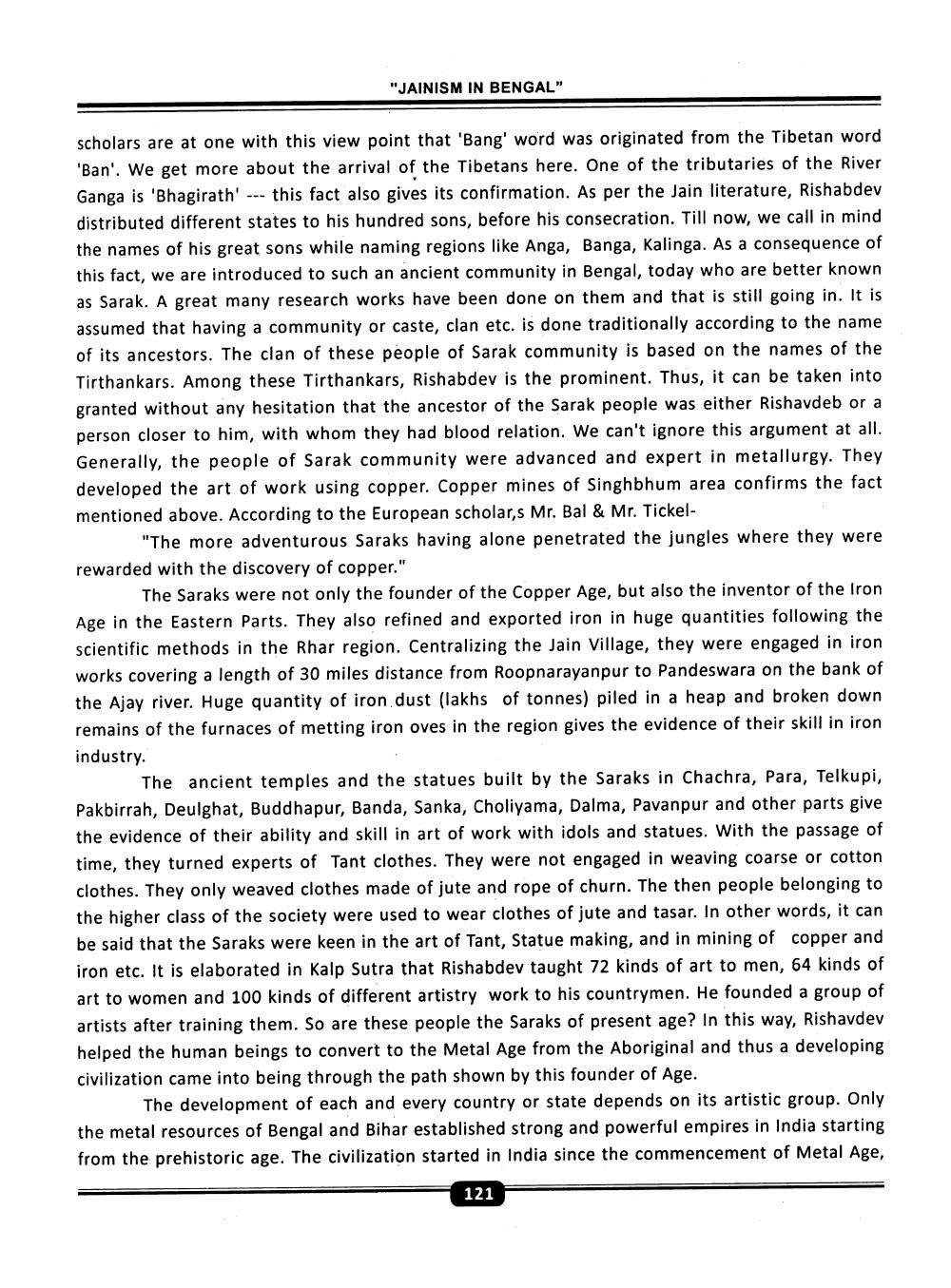________________
"JAINISM IN BENGAL"
scholars are at one with this view point that 'Bang' word was originated from the Tibetan word 'Ban'. We get more about the arrival of the Tibetans here. One of the tributaries of the River Ganga is 'Bhagirath' -- this fact also gives its confirmation. As per the Jain literature, Rishabdev distributed different states to his hundred sons, before his consecration. Till now, we call in mind the names of his great sons while naming regions like Anga, Banga, Kalinga. As a consequence of this fact, we are introduced to such an ancient community in Bengal, today who are better known as Sarak. A great many research works have been done on them and that is still going in. It is assumed that having a community or caste, clan etc. is done traditionally according to the name of its ancestors. The clan of these people of Sarak community is based on the names of the Tirthankars. Among these Tirthankars, Rishabdev is the prominent. Thus, it can be taken into granted without any hesitation that the ancestor of the Sarak people was either Rishavdeb or a person closer to him, with whom they had blood relation. We can't ignore this argument at all. Generally, the people of Sarak community were advanced and expert in metallurgy. They developed the art of work using copper. Copper mines of Singhbhum area confirms the fact mentioned above. According to the European scholar,s Mr. Bal & Mr. Tickel
"The more adventurous Saraks having alone penetrated the jungles where they were rewarded with the discovery of copper."
The Saraks were not only the founder of the Copper Age, but also the inventor of the Iron Age in the Eastern Parts. They also refined and exported iron in huge quantities following the scientific methods in the Rhar region. Centralizing the Jain Village, they were engaged in iron works covering a length of 30 miles distance from Roopnarayanpur to Pandeswara on the bank of the Ajay river. Huge quantity of iron dust (lakhs of tonnes) piled in a heap and broken down remains of the furnaces of metting iron oves in the region gives the evidence of their skill in iron industry.
The ancient temples and the statues built by the Saraks in Chachra, Para, Telkupi, Pakbirrah, Deulghat, Buddhapur, Banda, Sanka, Choliyama, Dalma, Pavanpur and other parts give the evidence of their ability and skill in art of work with idols and statues. With the passage of time, they turned experts of Tant clothes. They were not engaged in weaving coarse or cotton clothes. They only weaved clothes made of jute and rope of churn. The then people belonging to the higher class of the society were used to wear clothes of jute and tasar. In other words, it can be said that the Saraks were keen in the art of Tant, Statue making, and in mining of copper and iron etc. It is elaborated in Kalp Sutra that Rishabdev taught 72 kinds of art to men, 64 kinds of art to women and 100 kinds of different artistry work to his countrymen. He founded a group of artists after training them. So are these people the Saraks of present age? In this way, Rishavdev helped the human beings to convert to the Metal Age from the Aboriginal and thus a developing civilization came into being through the path shown by this founder of Age.
The development of each and every country or state depends on its artistic group. Only the metal resources of Bengal and Bihar established strong and powerful empires in India starting from the prehistoric age. The civilization started in India since the commencement of Metal Age,
121




